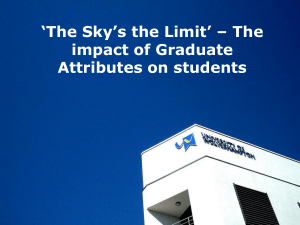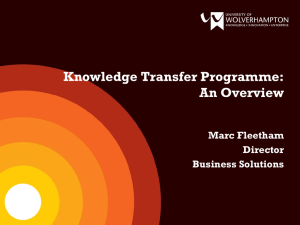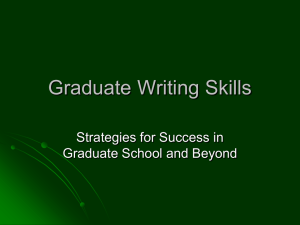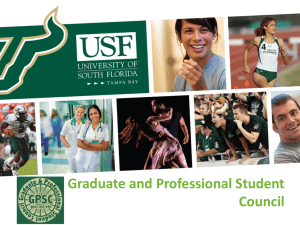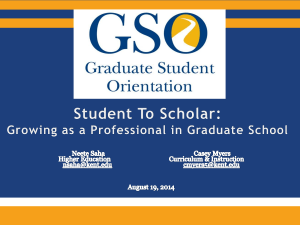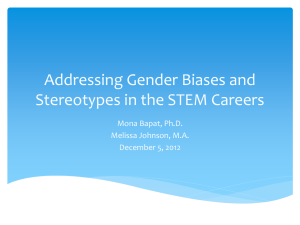Student: Lessons from the Life of E. E. Just by Dr. Malcolm Byrnes
advertisement
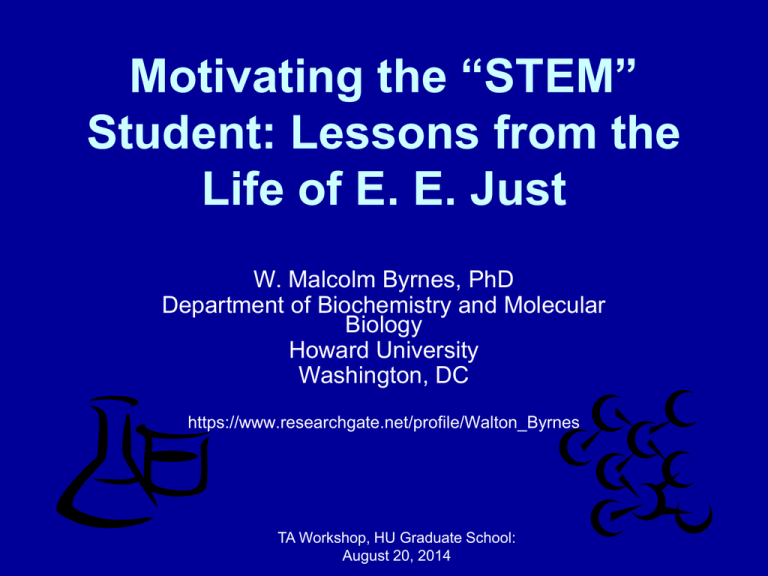
Motivating the “STEM” Student: Lessons from the Life of E. E. Just W. Malcolm Byrnes, PhD Department of Biochemistry and Molecular Biology Howard University Washington, DC https://www.researchgate.net/profile/Walton_Byrnes TA Workshop, HU Graduate School: August 20, 2014 What I Plan to Talk About • Something About Me • The Importance of Science, Technology, Engineering and Mathematics (STEM) • Ernest Everett Just • Questions for Discussion TA Workshop, HU Graduate School: August 20, 2014 A Bit about Me • BS: Xavier University of Our Fair Campus Louisiana (1981; chemistry) • PhD: LSU in Baton Rouge, LA (1994; biochemistry) • Did research at Cornell University in Ithaca, NY • Taught at college level and worked at NIST • Now: Associate Professor at Howard University • I study how enzymes work • Recently (2003) became interested in understanding legacy of E. E. Just • Write papers and give talks on Just TA Workshop, HU Graduate School: August 20, 2014 Why are Science, Technology, Engineering and Mathematics Important? 1. We live in a technological age. 2. Our problems require technological and scientific solutions. – Global climate change – Antibiotic resistance – Infectious disease (HIV-AIDS, Ebola) 3. Society needs to be scientifically informed in order to make good decisions TA Workshop, HU Graduate School: August 20, 2014 But science also allows us to be creative and satisfy our curiosity about the natural world. It helps us find our place in the universe. TA Workshop, HU Graduate School: August 20, 2014 Ernest Everett Just • Curious • Creative • Passionate • Persistent—overcame great obstacles • Was rejected • But ultimately was successful • Today there’s agreement that he was right about a lot of things. TA Workshop, HU Graduate School: August 20, 2014 TA Workshop, HU Graduate School: August 20, 2014 EE Just—Early Days • Born in Charleston, SC, in 1883 • Grew up on James Island • As a child, educated mostly by his mother • Attended – SC State College, – Kimball Union Academy and – Dartmouth College (1907) TA Workshop, HU Graduate School: August 20, 2014 Howard University and Woods Hole • Taught at Howard University (1907-1941) • English→ Biology→ Zoology Departments • Did research at the Marine Biological Laboratory (MBL) at Woods Hole, MA • PhD in embryology at University of Chicago (1916) • Studied fertilization in marine invertebrates TA Workshop, HU Graduate School: August 20, 2014 Howard University Woods Hole, MA Later Years E. E. Just, circa 1925. Courtesy of the MBL Archives • 1929 Onward: Spent a lot of time doing research in Europe – Naples, Italy – Berlin, Germany – Roscoff, France • Moved there permanently in 1938 (Roscoff) • Had to leave when Nazis invaded France • Died in 1941 TA Workshop, HU Graduate School: August 20, 2014 Just’s Contributions: Overview • Authored 2 books and ~70 papers in 30 years of work (1911-1941) • Examined how the egg cell cortex (ectoplasm) changes during development • Provided supporting evidence for F. R. Lillie’s “fertilizin” hypothesis of sperm-egg interaction • Correctly inferred existence of both fast and slow blocks to polyspermy • Proved that Jacques Loeb’s theory of experimental parthenogenesis was incorrect • Boldly challenged T. H. Morgan’s nucleocentric view of the cell • Was first to demonstrate an important role for cell surface in cell-cell adhesion during development • Probed internal structure of cells by examining movement of water into and out of eggs Fertilization: Union of sperm and egg to produce a new organism Steps: 1. Sperm attracted by egg 2. Acrosomal reaction occurs 3. Protein on sperm head binds to egg cell surface receptor* 4. Sperm and egg cell membranes fuse 5. Sperm nucleus released into egg cytoplasm 6. fertilization membrane forms* 7. Nuclei fuse *, Blocks to polyspermy occur Available at: http://www.sidwell.edu/us/science/vlb5/Labs/Urchin_Lab/ TA Workshop, HU Graduate School: August 20, 2014 Marine Invertebrates Whose Eggs and Embryos Just Studied A B D E C • A—Sand Dollar • B—Marine Worm (Platynereis dumerilii) • C—Parchment Worm D—Marine Worm (Nereis limbata) • E—Sea Urchin Taking on Thomas Hunt Morgan! • • • • • • Just boldly and publicly challenged prominent scientists: Loeb and Morgan 1935 annual meeting of the American Society of Zoologists Took Morgan to task for his nucleocentrism – Gene Theory: Genes are located in linear arrays on chromosomes in the nucleus (fine so far) – Genes in nucleus control all activities of the cell (oh no!) Just proposed cytoplasm-centered “theory of genetic restriction” to explain specialization of cells and tissues during cleavage and differentiation Both scientists incorrect; both theories too one-sided But Just more right than has been heretofore appreciated “As development progresses, the egg-potencies are restricted through their withdrawal from the cytoplasm by the chromosomes with each successive cell division. Thus the cytoplasm forms functional areas.” (The Biology of the Cell Surface) Lessons from the Life of Just • • • • • • Follow your passion Never give up Prepare for success Work hard Believe in yourself Don’t be afraid to challenge authority TA Workshop, HU Graduate School: August 20, 2014 Questions for Discussion • Do you think that E. E. Just provides a role model for junior scientists today? • If so, how? • If not, why not? • How might Just’s life story be used to motivate students? TA Workshop, HU Graduate School: August 20, 2014
